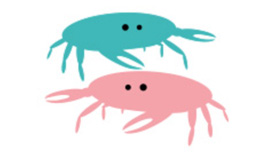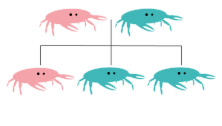

Alternative species (click on the thumbnail to see the card)
Names
Scientific name
Geosesarma sp.
Geosesarma sp « vampire »
Geosarma dennerle
Common name
Vampire crab
Origin

Origin: South East Asia, Indonesia
Biotope: non-specific
Dimorphism

The abdomen of the male is narrower than that of the female (the wide abdomen of the female allows her to store their eggs). Males are also more colourful
Group

Sesarmidae
Volume

40 L/ 9 Imp Gal / 11 US Gal
Parameters

T°: 23 to 28°C or 73 to 82°F
pH: /
Hardness: /
Difficulty

Easy
Size

2 to 5cm (0.8 to 2")
Longevity

/
Living zone

Middle and depth
Individuals

6
Food
How to feed the Vampire crabs?
Food
How to feed the Vampire crabs?
Crabs are scavengers and opportunists. Therefore, they are not very difficult to feed. Most of their diet should be carnivorous.
You can offer them specialized pellets that you will moisten beforehand. You can also opt for mud worms, artemia, earthworms, springtails and small amounts of green vegetables and carrots. From time to time, release a small cricket to stimulate their hunting instinct.
Provide calcium by providing a dry bone or eggshell (which you will renew very regularly). This will help your crabs to moult properly.
The best times to feed them are in the evening and in the morning (just after and before lighting the neon lights) as well as at night!
Tip: to avoid dirtying your installation, put the food in a small cup or any other support.
Behavior
What kind of behavior does the Vampire crabs have?
Behavior
What kind of behavior does the Vampire crabs have?
Vampire crabs are shy and reserved by nature. When they arrive at your home, they will need a little time to adjust, during which time your crabs will spend their time in hiding. However, in an environment that they like and that is safe, you should soon see them walking around!
They are quite earthy and don't bathe much after all. On the other hand, they are excellent climbers! They dig holes and burrows in the sand in which they take refuge.
Their activity is mainly twilight and night.
Vampire crabs periodically change their shells, and that's how they grow. They are said to moult. The abandoned moult is the exact copy of the crab but is entirely translucent. Just after a molt, the new shell is a little soft but will harden in a few hours. The crab is vulnerable during this period, and will try to hide while waiting for its armour to be ready! Finally, note that it is after a moult that the females are fertile.
Cohabitation
Who can live with the Vampire crabs?
Cohabitation
Who can live with the Vampire crabs?
Given their rather shy character, it is better to install them in a specific aquaterrarium.
Vampire crabs are social animals that need the presence of their congeners. Maintenance in pairs is the strict minimum, but a small group of 6 individuals will be much more adapted to their temperament! Of course, keep in mind that if all goes well, your aquaterrarium should soon have new small crabs (see "reproduction"). The recommended male/female ratio is one male for every two females.
Breeding
How to breed the Vampire crabs?
Breeding
How to breed the Vampire crabs?
The breeding of this species is very easy! In fact, if both sexes are present, reproduction takes place without any special intervention. Indeed, Geosesarma live and reproduce exclusively in fresh water, which makes it quite difficult compared to many other species of crabs whose larvae develop in salt water.
Births occur every 6 months, at a rate of about 50 small crabs per female.
At birth, the young are exact replicas of the adults: they are tiny little crabs. Their final coloration appears only after a few months.
You can leave them in the aquaterrarium with their parents because if everyone is well fed, there is no adult predation on the young.
Its paludarium
Which paludarium for the Vampire crabs?
Its paludarium
Which paludarium for the Vampire crabs?
In the wild, the vampire crab lives in warm, moist areas. In their aquaterrarium (or paludarium), they need the same atmosphere. To achieve this, close your tank tightly. Your lighting system should generate some heat. To check if this is sufficient, invest in a small thermometer and check that the temperature is at 25°C (77°F). If not, install a small hot plate of a few watts on one of the walls or at the bottom of your aquaterrarium.
For a very humid atmosphere, the combination of temperature and water point should be sufficient to cause this ambient humidity. If this is not the case, spray manually once or twice a day with water at room temperature. Check your aquaterrarium for leaks, especially at the lid. As far as air renewal is concerned, it will happen when you open your tank for maintenance and feeding.
On the water point side, install a small water pump that will ensure a small stirring to avoid stagnant water. The use of osmosis water, even if it is not mandatory, will avoid lime scale. Check the water level regularly as the water will evaporate. As the vampire crab is not really an aquatic crab, this part of the aquaterrarium can be quite restricted: 75% soil for 25% water. Depending on the configuration of your terrarium, a shallow water bowl may be sufficient. Indeed, in too much water, these crabs can drown! In any case, the height of your aquatic part will be rather low!
For the ground, install a drainage layer of coarse gravel or pozzolana. Cover with a thick layer (enough for the crabs to dig in) of sand or coconut mix and a few pebbles. Always litter the ground with dead leaves.
Finally, the decoration must be rich in hiding places, essential to reassure these shy adults. Plants, rocks and roots will form natural shelters that are much appreciated!
Good To know
Find all additional information!
Good To know
Find all additional information!
There are 50 species of Vampire Crab, and surely more not yet described!
Let's quote for example:
- Geosesarma aedituens
- Geosesarma albomita
- Geosesarma amphinoma
- Geosesarma angustifrons
- Geosesarma araneum
- Geosesarma aurantium
- Geosesarma sp. "Blue"
- Geosesarma "bicolor Krakatau-Vampirkrabbesemble"
It is quite recent in the aquarium world, with an appearance in 2006, and an official description in 2015!
Unfortunately, victims of their success, they are threatened in their natural environment. When you buy them, prefer breeding specimens (especially since they are very easy to reproduce!) rather than wild strains taken from the wild.
Yours photos!
Comments
Sort by:
Please login to post comments

